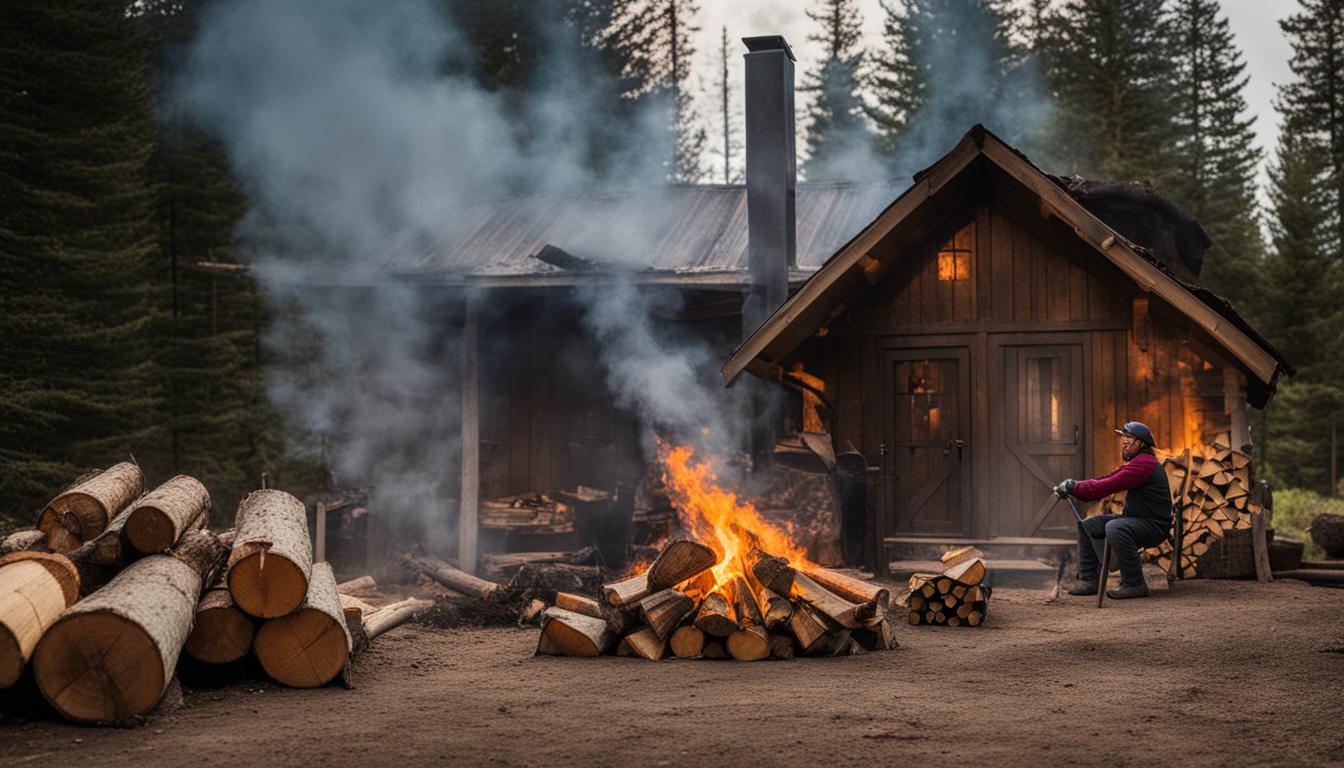Are you considering starting a firewood business? Look no further! This article will guide you through the essential steps to launch your own successful firewood company. Despite technological advancements, the demand for firewood remains strong, making it a lucrative venture in the energy market. Whether you’re looking for a main source of income or a side hustle, starting a firewood business can be an excellent opportunity.
To get started, it’s crucial to assess the market and identify potential customers. Understanding the demand for firewood in your target area will help you determine your target audience and tailor your business to meet their needs. Additionally, sourcing the right wood is essential for your business’s success. Whether you choose to log yourself, collaborate with local loggers, or recycle fallen trees, securing a consistent supply of quality timber is crucial.
In order to efficiently process the firewood, you’ll need to invest in the right equipment. This includes choosing the appropriate chainsaw, log splitter, and storage area. Properly seasoning the wood is another critical step, ensuring the optimal burning quality that customers desire. It’s also essential to familiarize yourself with licensing and regulations to operate your firewood business legally and responsibly.
In this article, we’ll delve into each step of starting a firewood business and provide you with valuable tips and insights to help you succeed in the competitive firewood market. From assessing the market and sourcing wood to choosing the right equipment and following regulations, we’ve got you covered. So let’s dive in and get your firewood business off to a blazing start!
Key Takeaways:
- Assess the market and identify your target audience
- Source quality wood through logging, collaborating with local loggers, or recycling fallen trees
- Invest in the right equipment, including chainsaws, log splitters, and storage areas
- Properly season the wood to ensure optimal burning quality
- Understand and comply with licensing and regulations
Assessing the Market
Before starting a firewood business, it’s crucial to assess the firewood business market and identify your target audience. Understanding the demand for firewood and identifying potential customers will help you tailor your business strategy and attract the right clientele.
Identifying Potential Customers
To tap into the firewood business market, consider targeting the following customer segments:
- Homeowners with wood-burning stoves or fireplaces
- Campgrounds and parks
- Restaurants with wood-fired ovens
- Local stores or gas stations offering firewood bundles
Conducting surveys and attending community meetings can provide valuable insights into customer preferences and the volume of wood they might require. Engaging in conversations with potential customers will also help you better understand their specific needs and tailor your offerings accordingly.
Market Research and Analysis
Investing time in market research will help you gain a deeper understanding of the firewood demand in your target area. Analyze factors such as heating fuel costs, prevalence of fireplaces, and camping opportunities to assess the potential size of the market. This research will help you better position your business and develop effective marketing strategies to reach your target audience.
Sourcing Your Wood
Securing a consistent and quality source of timber is essential for your firewood business. There are several methods you can use to source firewood, including logging yourself, collaborating with local loggers, or recycling fallen or discarded trees. It’s important to consider sustainable logging practices and adhere to local regulations before harvesting wood.
Logging Yourself
If you have access to woodlands, logging yourself can be a cost-effective option for sourcing firewood. This allows you to have full control over the process, from selecting the trees to cutting and processing the logs. However, it’s crucial to practice sustainable logging to preserve the environment and ensure a continuous supply of wood.
Collaborating with Local Loggers
An alternative approach is to partner with local loggers who already have the necessary equipment and expertise. This can save you time and resources, as the loggers will handle the logging and transportation of the wood. Establishing a relationship with reliable loggers in your area can provide you with a consistent supply of quality firewood.
Recycling Fallen or Discarded Trees
Another eco-friendly option is to recycle fallen or discarded trees. Many trees are cut down due to storms, disease, or construction projects, and their wood can be salvaged for firewood. By working with tree removal services or local arborists, you can acquire this wood at a lower cost or even for free, while also reducing waste.
Remember, regardless of the method you choose, it’s essential to ensure the wood you source is of high quality. This ensures customer satisfaction and ensures efficient burning. Take the time to properly inspect and assess the wood’s condition before processing and selling it as firewood.
Choosing the Right Equipment
Selecting the appropriate equipment is crucial for a successful firewood business. When it comes to firewood business equipment, there are several key essentials to consider:
- Chainsaw: Invest in a high-quality chainsaw with the right power and safety features. Look for trusted brands like Stihl or Husqvarna that offer reliable performance and durability.
- Log Splitter: To expedite the wood processing, a log splitter is a game-changer. Look for a log splitter that suits the volume of wood you plan to process and consider both hydraulic and manual options.
- Truck or Trailer: In order to transport logs from the source to your storage area, having a truck or trailer is essential. Choose a vehicle with ample capacity and consider features like a hydraulic lift or trailer brakes for added convenience and safety.
- Storage Area: A dedicated storage area like a shed or barn is crucial for drying and organizing the firewood. Ensure the storage area is well-ventilated and protected from the elements to prevent moisture buildup and ensure the wood remains in optimal condition.
Investing in quality equipment will not only enhance your productivity but also contribute to the overall efficiency and success of your firewood business. By maintaining and properly using the essential tools, you can streamline your operations and meet the demands of your customers effectively.
Seasoning the Wood
Properly seasoning firewood is essential to ensure optimal burning quality. By following the right techniques, you can achieve dry, well-seasoned wood that burns efficiently and produces less smoke. Here are some key steps to consider:
1. Stacking
To facilitate efficient drying, it is important to stack the wood properly. By creating a stack with good airflow, you allow the wood to dry more effectively. Consider using pallets or raised platforms to elevate the wood off the ground and promote better air circulation. This will help prevent moisture buildup and minimize the risk of mold or rot.
2. Covering
While it’s crucial to allow air to circulate around the wood, you should also protect it from direct rain or snow. By covering the wood with a waterproof tarp, you can shield it from precipitation while still enabling air movement. This helps maintain the dryness of the wood and prevents it from absorbing moisture, which can lead to difficulties in burning and increased smoke output.
3. Time
The duration of seasoning varies depending on the type of wood and the desired moisture content. Softwoods generally require less time to season compared to hardwoods. Softwoods like pine may take around 6-12 months, while hardwoods such as oak or maple may need 1-2 years to properly dry. Monitoring the moisture content using a moisture meter can help determine when the wood is adequately seasoned.
By following these seasoning techniques, you can ensure that your firewood is dried to the appropriate moisture level, resulting in cleaner and more efficient fires. Properly seasoned wood not only provides a more enjoyable and hassle-free burning experience but also improves the longevity of your equipment and reduces the environmental impact of your firewood business.
Licensing and Regulations
Operating a firewood business requires a thorough understanding of licensing and regulations to ensure compliance and avoid potential penalties. To legally establish your firewood business, you will need to obtain the necessary licenses and permits. One crucial license to obtain is a commercial license, which allows you to conduct business operations in the firewood industry. It is important to research and understand the specific requirements and application process for firewood business licenses in your state or local jurisdiction.
In addition to licensing, you may also need to comply with land-use permits if you plan on logging or harvesting the wood yourself. These permits ensure that the activities associated with wood sourcing and processing are in compliance with environmental and land management regulations. Make sure to check with the appropriate local authorities to assess any specific permits or permissions required for your firewood business.
Zoning regulations are another crucial aspect to consider when starting a firewood business. These regulations dictate where and how businesses can operate within a given area. It is important to research and understand the zoning regulations in your location to ensure that your firewood business complies with the designated zoning designation. This helps to avoid potential conflicts with residential or commercial areas and any associated fines or penalties.
By understanding and adhering to licensing, land-use permits, and zoning regulations, you can operate your firewood business legally and avoid unnecessary complications. Research the specific requirements in your area, consult with local authorities if needed, and ensure that your business operates within the guidelines set forth by regulatory bodies.
Knowing the Firewood Market
Understanding the firewood market is crucial for the success of your firewood business. Various factors contribute to the dynamics of the market, including the types of firewood, customer demand, and the duration of the firewood season, which can vary depending on your location. Conducting a thorough market analysis will enable you to identify the specific demand for firewood in your target area and make informed business decisions.
Start by researching the heating fuel costs in your region. Areas with higher energy prices and colder climates are more likely to have a strong demand for firewood. Additionally, consider the prevalence of fireplaces and wood-burning stoves in local homes. These heating options can significantly contribute to the demand for firewood as homeowners seek an alternative to traditional heating systems.
Another essential aspect to consider is the popularity of camping and outdoor activities in your area. Many outdoor enthusiasts rely on firewood for campfires or cooking while exploring nature. Understanding the camping opportunities and the demand for firewood in popular camping spots will help you tap into this market segment.
During your market analysis, assess the competition in your area. Identify existing firewood suppliers and understand their pricing, quality standards, and customer base. This knowledge will allow you to position your business strategically and differentiate yourself by offering unique value propositions, such as superior quality or convenient delivery options.
By comprehensively analyzing the firewood market and considering these factors, you can gain valuable insights into customer demand, pricing strategies, and other market dynamics. This information will guide your business decisions and help you tailor your offerings to meet the specific needs of your target audience.
Image: Firewood Market Analysis
Setting Firewood Goals
When starting a firewood business, it’s crucial to set clear goals that align with your vision for profitability and expansion. Whether you see it as a full-time venture or a part-time side hustle, defining your goals will provide direction and help you make informed decisions.
Begin by considering your desired level of profitability. Determine how much income you aim to generate from your firewood business and the timeframe in which you hope to achieve it. This will guide your budgeting and pricing strategies to ensure your business remains financially sustainable.
As you establish your goals, take into account the equipment required to meet the demands of your customers. For example, log splitters can significantly increase your productivity and efficiency. Analyze your target market and forecast the volume of firewood you need to produce to achieve your profitability goals.
Additionally, plan for growth and expansion as your customer base and demand increase. Identify opportunities to expand your offerings, such as providing delivery services, bundled firewood, or related products like fire starters. Stay agile and be prepared to adapt to emerging trends and customer preferences in the firewood market.
Key Points:
- Set clear goals for profitability and expansion.
- Define your desired level of income and the timeframe to achieve it.
- Consider the equipment needed, such as log splitters, to meet your goals.
- Plan for growth and be open to diversifying your offerings as demand increases.
Providing Quality Firewood
When running a firewood business, it’s crucial to provide customers with clean and presentable firewood. By ensuring the quality of your firewood, you can attract and retain satisfied customers. Here are some key practices to follow:
Removing Debris and Filtering
Before delivering your firewood, it’s important to remove any debris and ensure a pristine look. One effective method is to use a table grate and a disc screener. These tools help filter out unwanted debris such as twigs, leaves, and bark, leaving behind clean firewood that is ready for use.
Bundling for Profitability and Professionalism
Consider investing in a firewood bundler for your business. This machine simplifies the process of bundling firewood, making it more efficient and cost-effective. Bundling firewood not only enhances its presentation but also increases profitability, as customers are often willing to pay more for neatly bundled firewood. This practice also gives your business a professional appearance, establishing trust and credibility with customers.
Expanding Firewood Processing Operation
As demand for your firewood grows, it’s important to expand your firewood processing operation. This may involve investing in additional equipment, hiring more staff, or increasing production capacity. By scaling your operation appropriately, you can meet customer demands while maintaining the quality of your firewood.
Remember, providing clean firewood and using efficient processing techniques are essential for the success and growth of your firewood business. By delivering high-quality firewood, you can build a loyal customer base and establish your business as a trusted provider in the market.
Finding Wood Sources
Finding reliable sources of firewood is crucial for the success of your firewood business. If you don’t have access to a large property with trees, there are several options you can explore to ensure a steady supply of firewood.
- Collaborate with friends or family who own wooded properties: Establish partnerships with individuals who have ample trees on their properties. This collaboration can be mutually beneficial, as you provide the labor and equipment needed for tree removal, while they supply you with the necessary wood.
- Offer tree removal services: In addition to sourcing firewood, you can expand your business offerings by providing tree removal services. This allows you to acquire wood from the trees you remove, giving you a steady supply of firewood while generating additional revenue.
- Purchase wood from lumberyards: If sourcing wood independently is challenging, consider purchasing wood from reputable lumberyards or wood suppliers. Make sure the wood meets quality standards and is suitable for firewood purposes.
When sourcing firewood, it’s important to prioritize sustainable practices. Ensure that any tree removal is conducted responsibly, considering environmental impact and local regulations.
Choosing Wood Types
The type of wood you choose to sell in your firewood business can significantly impact customer preferences and burning quality. When selecting wood types, it’s crucial to consider the demand for different varieties and understand their characteristics and burning qualities.
Hardwoods like oak and maple are often preferred by homeowners with fireplaces or wood stoves. They are known for their dense and long-burning properties, providing a sustained heat source. These hardwoods produce a pleasant aroma and are sought after for their beautiful flame colors and minimal smoke output.
On the other hand, softwoods like pine may be more suitable for camping or outdoor fires. They ignite quickly and are ideal for creating a cozy and inviting atmosphere while enjoying a bonfire. Softwoods often produce crackling sounds and aromatic scents, enhancing the outdoor experience.
Understanding customer preferences is crucial to meet their needs effectively. Offering a variety of firewood types can cater to a wider range of customers and their specific requirements. Consider conducting market research or engaging in conversations with potential customers to gauge the demand for different wood types in your area.
Remember, educating your customers about the different wood types and their characteristics can also help them make informed decisions. Provide clear and concise information, such as burn times, heat output, and suitability for specific applications.
Benefits of Hardwoods:
- Dense and long-burning
- Pleasant aroma
- Beautiful flame colors
- Minimal smoke output
Benefits of Softwoods:
- Quick ignition
- Cozy and inviting atmosphere
- Crackling sounds
- Aromatic scents
Conclusion
Starting a successful firewood business requires careful planning and attention to various factors. By conducting thorough market analysis, sourcing quality wood, choosing the right equipment, properly seasoning the wood, and understanding licensing and regulations, you can position yourself for success in this competitive industry.
Setting clear goals and continuously evaluating your business strategy is crucial for staying ahead of customer demands. Providing clean and quality firewood not only attracts customers but also helps retain them. Additionally, consider expanding your firewood processing operation as demand grows to meet the needs of a larger customer base.
Remember, starting a firewood business is not just about selling wood; it’s about providing a valuable product that enhances the lives of your customers. By following these tips and staying dedicated to excellence, you can build a thriving firewood business that meets customer demands and drives your success in the market.
FAQ
How do I start a firewood business?
Starting a firewood business requires careful planning, market analysis, sourcing quality wood, choosing the right equipment, properly seasoning the wood, and understanding licensing and regulations. It’s important to set goals, provide clean and quality firewood, and continuously evaluate and adjust your business strategy to meet customer demands and drive success in the competitive firewood market.
How do I assess the firewood market?
To assess the firewood market, you need to identify potential customers such as homeowners with wood-burning stoves or fireplaces, campgrounds and parks, restaurants with wood-fired ovens, and local stores or gas stations offering firewood bundles. Conduct surveys, attend community meetings, and engage in conversations to gain insights into customer preferences and the volume of wood they might require.
Where can I source my firewood?
You can source your firewood by logging yourself if you have access to woodlands, collaborating with local loggers, or recycling fallen or discarded trees. Ensure you consider sustainable logging practices and local regulations before harvesting wood to ensure a consistent and quality supply.
What equipment do I need for a firewood business?
You will need equipment such as a chainsaw with the right power and safety gear, a log splitter to expedite the process, a truck or trailer for transporting logs, and a storage area like a shed or barn to dry and organize the wood.
How do I properly season firewood?
To properly season firewood, you need to stack the wood using proper techniques that facilitate efficient drying, such as using pallets or raised platforms for airflow. It’s important to cover the wood with a tarp to protect it from direct rain or snow while allowing for air circulation. The seasoning duration varies depending on the type of wood, with hardwoods requiring longer drying periods.
What licensing and regulations do I need to consider for a firewood business?
Operating a firewood business requires obtaining the necessary business licenses, such as a commercial license, and complying with land-use permits if logging yourself. It’s important to research and adhere to local zoning regulations to avoid fines or sanctions.
What should I know about the firewood market?
Understanding the firewood market is crucial for a successful business. Factors such as the types of firewood, customer demand, and the duration of the firewood season vary depending on the location. Conduct market research to identify the specific demand for firewood in your target area and consider factors such as heating fuel costs, prevalence of fireplaces, and camping opportunities.
How do I set goals for a firewood business?
Defining your goals for the firewood business is important. Determine if you aim for a profitable business or a side hustle. Establish a budget and consider the equipment needed, such as log splitters, to meet your goals. Plan for growth and expansion as your customer base and demand increase.
How do I provide quality firewood?
Providing clean and presentable firewood is essential for attracting and retaining customers. Using a table grate and a disc screener can help remove debris and filter the firewood for a pristine look. Consider using a firewood bundler to bundle the wood, as this can increase profitability and provide a professional appearance. Expand your firewood processing operation as demand grows.
Where can I find wood sources for my business?
If you don’t have a large property with trees, you can consider collaborating with friends or family who have wooded properties, offering tree removal services, or purchasing wood from lumberyards. Ensure the wood meets quality standards, and consider sustainable sourcing practices.
Which types of wood should I choose to sell?
The type of wood you choose to sell can greatly impact customer preferences and burning quality. Consider the demand for different wood types, such as hardwoods like oak and maple, which are often preferred by homeowners with fireplaces or wood stoves. Softwoods like pine may be more suitable for camping or outdoor fires. Understand the characteristics and burning qualities of different wood types to meet customer needs.




